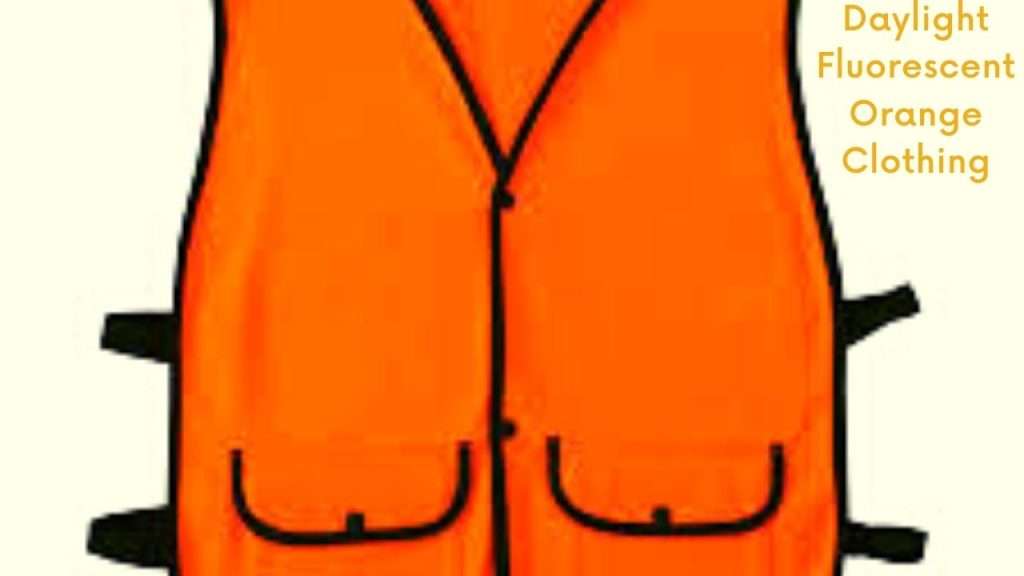Last updated on April 30th, 2022 at 12:48 pm
Hunting is a national hobby in the United States, with roughly 15% of the population participating in it. To avoid mishaps, these hunters are expected to dress in a way that makes them visible to other people and animals.
Daylight bright orange hunting apparel is one form of clothing that is created for this purpose. The advantages of wearing this sort of clothing are discussed in this article, along with some suggestions. Hunter safety is improved by wearing fluorescent orange (hunter orange) and/or pink apparel, which is visible to other hunters in the field.
Wearing daytime neon orange clothes allows the hunters to be spotted by others while out in the field. The vivid colors aren’t for the hunter’s benefit, but for the benefit of other individuals in the area. They will be able to prevent firearm mishaps or near-collisions when hunting as a result of this.
Hunters, for example, are more likely to prevent weapon mishaps if they wear bright orange. This is because it makes them stand out in the landscape, allowing others to detect their presence. Another reason hunters should wear light neon orange apparel is to avoid being mistaken for animals or things such as trees and rocks by other outdoor enthusiasts.
Keynote
The colors assist in identifying people from everything else, reducing the risk of deadly run-ins and collisions between wildlife and cars/trucks, among other things, when moving through nature where outside areas cross.
This extra precaution is one that everyone should take, whether they are hunting during daylight hours or not because it is the greatest way to protect ourselves from natural hazards as well as those led astray by man-made items such as vehicles, which are found all over the world nowadays.
Overview: Hunting Clothes
Public health concerns about Lyme disease are a reason why hunters should wear daytime neon orange gear. Ticks carrying the illness are more likely to attach to someone dressed in hunter’s attire than someone dressed in brighter-colored apparel. This increases the chances of the tick being discovered and removed before it can transmit Lyme disease to its host via blood-feeding, which might result in infection.
With all of this in mind, no matter how skilled a hiker, camper, or hunter you are, you should always take care since accidents may happen even when everything appears to be going well. Finally, if you’re ever confused about whether something qualifies as “daylight bright orange,” look it up in your state’s official hunting laws; it should be noted there.
Is it Possible to Wear a Color Other Than Fluorescent Orange?

No. When hunting, you should not wear any other color of clothes because it is forbidden in several states and provinces. When going on a hunt, hunters must always wear bright orange during the daytime.
The purpose of this color is to make hunters visible even at sunset. It makes no difference what time of day or year it is, because even when it’s dark outdoors during the winter months, brightly colored clothing may be seen from afar! Some animals, however, are unable to see this color clearly, which might help you stay safe when hunting.
Is it Worth It to Wear Camouflage with Fluorescent Orange Clothes?
When it comes to hunting, hunters must remember two things: keep concealed and be noticed. Deer can see quite well in low-light situations, so hunters must blend into the backdrop as much as possible. This is why many individuals use camouflage clothing when hunting.
However, for them, there might not be enough natural greenery surrounding them to effectively conceal their movement or clothing, which might potentially reveal their location if a person observes from afar.
Editors’ note:
Many hunters combine apparel with camouflage costumes that are designed to be observed by others. This sort of apparel is known as “daylight bright orange” since it was created with the intention of deer being able to notice the color from a distance and prevent being hit by hunters while hunting on land.
Caution: One thing to remember about daytime bright orange clothing is that it should never be used as a substitute for a decent camouflage suit. Many hunters prefer to put on both before going out hunting since it provides them an advantage over the animals observing from afar.
It also allows those who are unfamiliar with hunting to see where you are and what your plans are when you’re hidden behind some bushes waiting for the right moment to take a shot at one of these wonderful beasts!
Hunter Safety Tips
- Camouflage clothing should not be worn in conditions other than deer seasons, such as hiking or gardening. It might lead folks who aren’t paying attention to their surroundings to believe that someone is hidden in their backyard! Wearing camouflage is only acceptable during certain seasons, such as deer season.
- When trying to discern movement through dense bushes and trees during low-light circumstances like dawn and twilight, black is equally taxing on everyone’s eyes.
- Wear bright colors and loose-fitting clothing. As you walk through hunting regions, this makes you more visible and reduces the possibility of your clothes snagging on bushes or limbs.
- In low-light situations, such as at dawn and twilight, blaze orange is less effective. Daylight bright orange, on the other hand, stands out against green foliage and brown tree trunks, making it simpler for others to locate you immediately in the event of a possible safety concern. This hue has been scientifically demonstrated to be an excellent option since its brightness level fluctuates less than the standard blazing orange overtime when visibility levels decline due to sunshine exposure.
- Wearing black or camouflage clothes is not a good idea. These hues blend with the trees, making them harder to identify by other hunters. Because bright clothing can save your life while hunting in the woods, it’s critical to avoid wearing dark colors.
- If you’re heading into deep foliage where hunters can’t detect movement, you could be safer wearing a hat with a brim that protects your eyes from the sun than an all-over jacket.
List of Apparels that Hunters and Their Should Wear
- A neon orange and/or pink camouflage outer garment is worn above the waist that has at least a 50% fluorescent orange and/or pink hue.
- Solid neon orange and/or pink cap is worn on the head at all times as an outer garment.
- A vest or jacket with at least 250 square inches of solid bright orange and/or pink hue on the back and front is worn as outer clothing at all times.
People required to wear fluorescent orange and/or pink who hunt from a ground blind with four sides, a top, and a height of 4 feet or less must wear a cap of solid fluorescent orange color or a panel, band, strip, or garment containing at least 250 square inches (approximately 16″ x 16″) of solid fluorescent orange and/or pink color on or within 25 feet of the ground blind.
Keep in mind that:
- During the open black bear season, deer archery hunters in Allegany, Frederick, Garrett, and Washington counties must wear neon orange and/or pink.
- During the Junior Deer Hunting Days, Deer Firearms, and Deer Muzzleloader Seasons, those who hunt with archery equipment must wear neon orange and/or pink.
- Children, spouses, and property owners (who are hunting on their land) must all wear luminous orange or pink.
Who are those that are exempted from the requirement of wearing fluorescent orange or pink colors?
- Someone who uses falcons, hawks, or owls to hunt game birds or animals and has a falconry permit.
- A person who hunts deer during the deer archery season, except as mentioned above.
- A person who hunts the following species or who accompanies helps, or supports another person hunting them:
- Crow
- Coot
- Ducks
- Rails
- Wild Turkey
- Dove-fur-
- bearing mammals
- Snipe
- Brant
- Geese
How to Get Ready for Your Next Hunting Trip
When going on a hunting trip, preparation is everything. If you’re new to hunting and don’t know what to wear on a hunting expedition, this section will be of help. Even though winter is approaching, it’s never too early to start thinking about hunting gear. They’re also a great present for any hunter you know.
1. Blaze It With Orange
To differentiate yourself from other hunters, several states require you to wear orange blaze accessories. So, first and foremost, figure out what those needs are. You may require different accessories depending on the season. Vests, headgear, caps, beanies, and gloves are available at reasonable costs from many outdoor retailers and hunting brands.
2. Layer your outfit.
Warmth is the buzzword for the forthcoming winter season. It’s crucial to be comfortable, especially if you’re intending on making it an all-day event. Investing in layers will pay off since insulated clothing is your best bet.
Gloves, caps, boots, thick socks, undershirts, trousers, jackets, and coats are all items that should be included in your shopping basket. Early fall hunting may not necessitate a thick coat and gloves, but rather a long-sleeved shirt and jacket. Consider investing in a billed hat to protect your eyes from the blazing sunlight or sunset.
3. Dress appropriately for the type of hunting you’ll be doing.
You’ll almost certainly be near water if you’re going waterfowl hunting. If it’s autumn, opt for lightweight, water-resistant apparel. If it’s winter, insulated camo will keep you warm in frigid water. Choose waders if you plan on playing decoys in the water. Waterproof trousers and boots are required for hunting in the marshes.
FAQ
Which of these materials keeps hunters warm even while it’s raining?
Even when a hunter is wet, wool provides warmth. It is the best while it is raining. Wool does not become soggy when exposed to moisture and can still give some insulation against the cold when out in nature waiting for its target to appear or the hunting season to expire (if it is an open season at the time).
Why is it necessary for hunters to dress properly?
Hunters need it since they are out in the wilds of nature. They must wear neon orange clothes throughout the day so that vehicles can see them from a long distance and avoid an accident or, worse, being hit by a car on purpose because they don’t want animals near their land.
When hunting, why is it vital to dress in layers?
When hunting, layering will indeed help you manage your temperature, whether it is too hot or too cold. If the weather changes, instead of being out there feeling chilly because they have nothing on but their garments for warmth, one may remove an article of clothing that they are no longer comfortable wearing and keep warm.
What does proper hunting clothing entail?
People driving cars will be able to notice the hunter in time and will not try to hit him with their vehicle out of rage that animals are wandering into residential areas and causing damage. Proper clothing includes daytime fluorescent orange clothing so that people driving cars will be able to notice the hunter in time and will not try to hit him with their vehicle in a rage that animals are wandering into residential areas and causing damage (e.g., destroying gardens).
In Summary
Finally, there are a variety of reasons why hunters should wear daylight fluorescent orange clothing. These include:
- They take safety precautions for themselves and others to avoid firearm accidents.
- Traffic collisions involving wildlife and people.
- Public health concerns about Lyme disease transmission via ticks among humans (particularly those engaged in outdoor recreation)
- Protecting natural habitats from human disturbance.
Conclusion
In addition to the advantages of wearing brilliant orange clothes when hunting, hunters who wear camouflage outfits seem more stunning in the woods. This article, I feel, has offered some useful information on the subject of hunting in neon orange clothes. We hope you now have a better grasp of why hunters use this sort of gear and what it does for them in the field!





